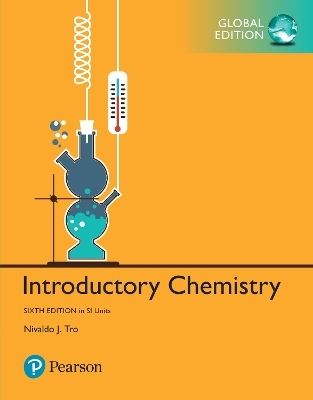
Introductory Chemistry in SI Units
Pearson Education Limited (Verlag)
978-1-292-22968-3 (ISBN)
Builds 21st century and problem solving skills, preparing students for success
Now in its 6th Edition, the best-selling Introductory Chemistry continues to encourage student interest by showing how chemistry manifests in students’ daily lives. Author Nivaldo Tro draws upon his classroom experience as an award-winning instructor to extend chemistry from the laboratory to the student’s world, capturing student attention with relevant applications and an engaging writing style. The text provides a superior teaching and learning experience, enabling deep conceptual understanding, fostering the development of problem-solving skills, and encouraging interest in chemistry with concrete examples. Extending chemistry from the lab to the student’s world, the text reveals that anyone can master chemistry.
Refined to meet its purpose of teaching relevant skills, the 6th Edition includes new questions, data, and sections to help students build the 21st century skills necessary to succeed in introductory chemistry and beyond. Already a visual text, in this edition the art has been further refined and improved, making the visual impact sharper and more targeted to student learning. The new edition also includes new Conceptual Checkpoints, a widely embraced feature that emphasizes understanding rather than calculation, as well as a new category of end-of-chapter questions called Data Interpretation and Analysis, which present real data in real life situations and ask students to analyze and interpret that data.
Also available with Mastering Chemistry.
MasteringTM Chemistry from Pearson is the leading online homework, tutorial, and assessment system, designed to improve results by engaging students with powerful content. Instructors ensure students arrive ready to learn by assigning educationally effective content and encourage critical thinking and retention with in-class resources such as Learning CatalyticsTM. Students can further master concepts through homework assignments that provide hints and answer-specific feedback. The Mastering gradebook records scores for all automatically graded assignments in one place, while diagnostic tools give instructors access to rich data to assess student understanding and misconceptions.
Note: You are purchasing a standalone product; MasteringTM Chemistry does not come packaged with this content. Students, if interested in purchasing this title with Mastering Chemistry, ask your instructor for the correct package ISBN and Course ID. Instructors, contact your Pearson representative for more information.
The Chemical World
Sand and Water
Chemicals Compose Ordinary Things
The Scientific Method: How Chemists Think
Analyzing and Interpreting Data
A Beginning Chemist: How to Succeed
Measurement and Problem Solving
The Metric Mix-up: A $125 Million Unit Error
Scientific Notation: Writing Large and Small Numbers
Significant Figures: Writing Numbers to Reflect Precision
Significant Figures in Calculations
The Basic Units of Measurement
Problem Solving and Unit Conversion
Solving Multistep Unit Conversion Problems
Unit Conversion in Both the Numerator and Denominator
Units Raised to a Power
Density
Numerical Problem-Solving Strategies and the Solution Map
Matter and Energy
In Your Room
What Is Matter?
Classifying Matter According to Its State: Solid, Liquid, and Gas
Classifying Matter According to Its Composition: Elements, Compounds, and Mixtures
Differences in Matter: Physical and Chemical Properties
Changes in Matter: Physical and Chemical Changes
Conservation of Mass: There Is No New Matter
Energy
Energy and Chemical and Physical Change
Temperature: Random Motion of Molecules and Atoms
Temperature Changes: Heat Capacity
Energy and Heat Capacity Calculations
Atoms and Elements
Experiencing Atoms at Tiburon
Indivisible: The Atomic Theory
The Nuclear Atom
The Properties of Protons, Neutrons, and Electrons
Elements: Defined by Their Numbers of Protons
Looking for Patterns: The Periodic Law and the Periodic Table
Ions: Losing and Gaining Electrons
Isotopes: When the Number of Neutrons Varies
Atomic Mass: The Average Mass of an Element's Atoms
Molecules and Compounds
Sugar and Salt
Compounds Display Constant Composition
Chemical Formulas: How to Represent Compounds
A Molecular View of Elements and Compounds
Writing Formulas for Ionic Compounds
Nomenclature: Naming Compounds
Naming Ionic Compounds
Naming Molecular Compounds
Naming Acids
Nomenclature Summary
Formula Mass: The Mass of a Molecule or Formula Unit
Chemical Composition
How Much Sodium?
Counting Nails by the Pound
Counting Atoms by the Gram
Counting Molecules by the Gram
Chemical Formulas as Conversion Factors
Mass Percent Composition of Compounds
Mass Percent Composition from a Chemical Formula
Calculating Empirical Formulas for Compounds
Calculating Molecular Formulas for Compounds
Chemical Reactions
Grade School Volcanoes, Automobiles, and Laundry Detergents
Evidence of a Chemical Reaction
The Chemical Equation
How to Write Balanced Chemical Equations
Aqueous Solutions and Solubility: Compounds Dissolved in Water
Precipitation Reactions: Reactions in Aqueous Solution That Form a Solid
Writing Chemical Equations for Reactions in Solution: Molecular, Complete Ionic, and Net Ionic Equations
Acid—Base and Gas Evolution Reactions
Oxidation—Reduction Reactions
Classifying Chemical Reactions
Quantities in Chemical Reactions
Climate Change: Too Much Carbon Dioxide
Making Pancakes: Relationships between Ingredients
Making Molecules: Mole-to-Mole Conversions
Making Molecules: Mass-to-Mass Conversions
More Pancakes: Limiting Reactant, Theoretical Yield, and Percent Yield
Limiting Reactant[JJ2]
| Erscheinungsdatum | 02.10.2018 |
|---|---|
| Verlagsort | Harlow |
| Sprache | englisch |
| Maße | 215 x 275 mm |
| Gewicht | 1633 g |
| Themenwelt | Schulbuch / Wörterbuch |
| Naturwissenschaften ► Chemie | |
| ISBN-10 | 1-292-22968-3 / 1292229683 |
| ISBN-13 | 978-1-292-22968-3 / 9781292229683 |
| Zustand | Neuware |
| Informationen gemäß Produktsicherheitsverordnung (GPSR) | |
| Haben Sie eine Frage zum Produkt? |
aus dem Bereich


